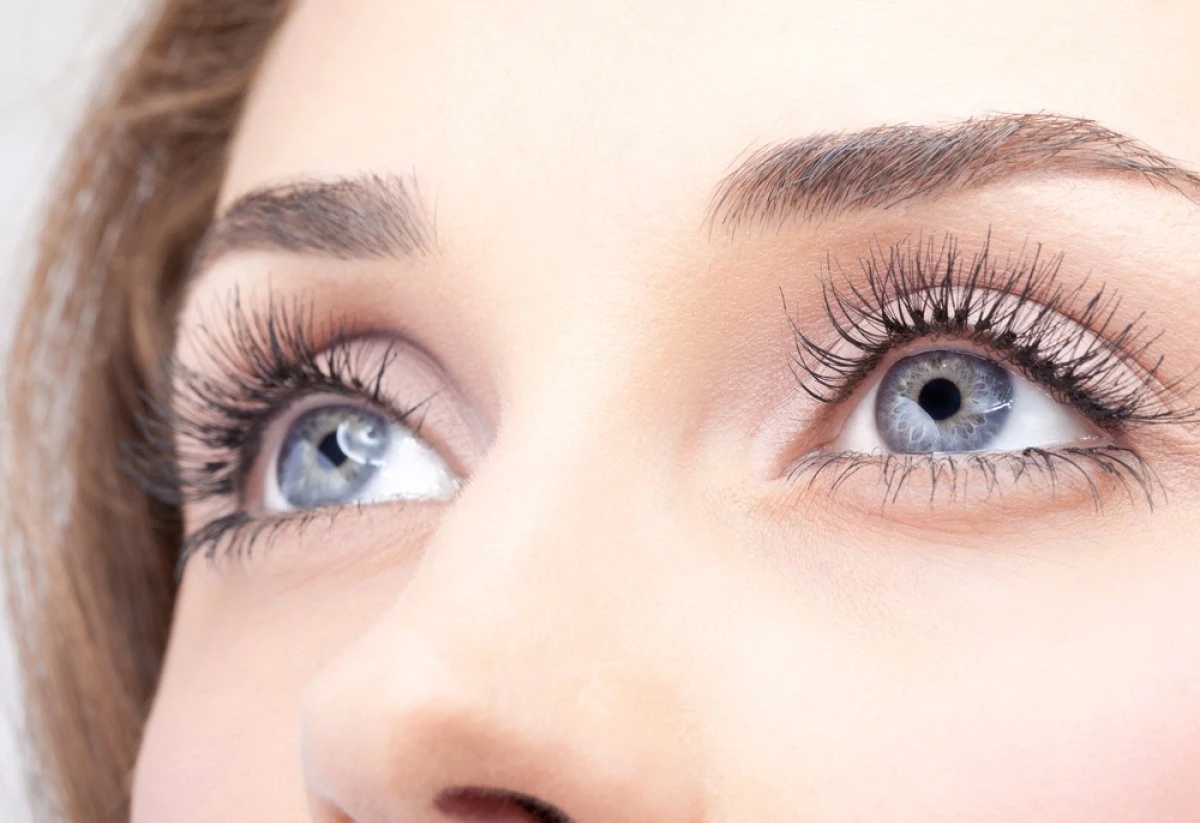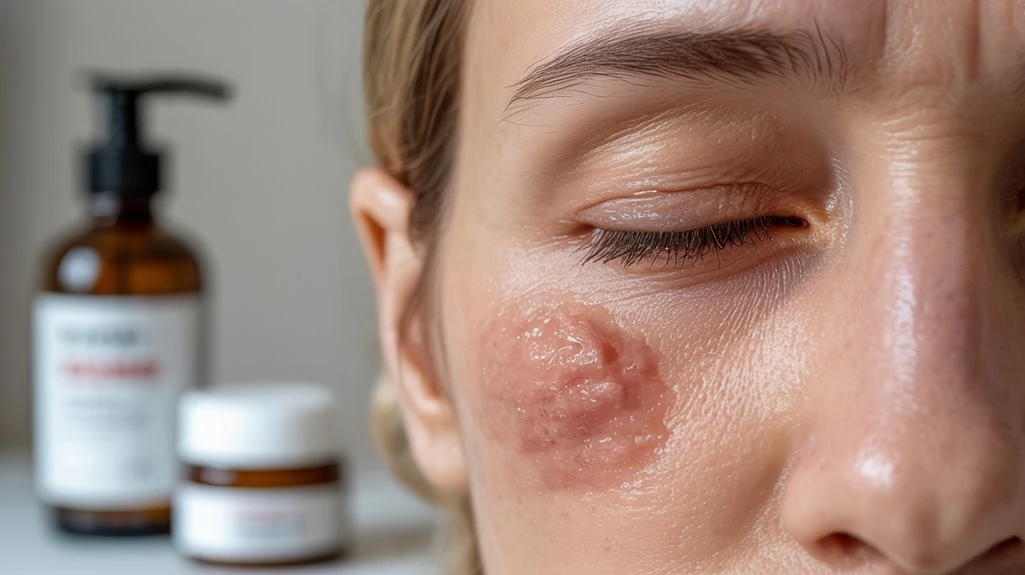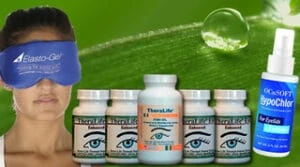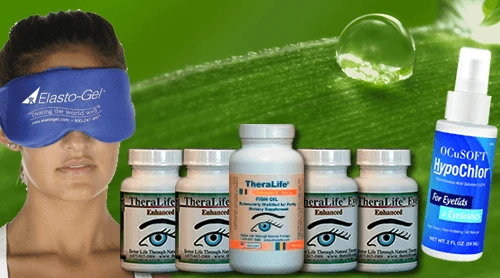Dry eyelids can be attributed to several factors, such as environmental triggers like low humidity, wind, and sudden temperature changes, which accelerate water loss from the delicate skin of the eyelids. Allergic reactions to pollen, pet dander, or dust mites, as well as irritating skincare or makeup products, can compromise the skin barrier. Chronic skin conditions like eczema or psoriasis and frequent eye rubbing can further decrease moisture. Additionally, certain medications and hormonal changes may exacerbate dryness.
TheraLife is uniquely positioned to help manage these symptoms, as it is the only company providing oral eye treatment care. TheraLife‘s products offer a comprehensive approach to eye health by addressing the root causes of dryness and promoting overall eye comfort. Their solutions are designed to restore moisture balance and protect the delicate skin of the eyelids. By understanding these contributing factors, customers can better manage their symptoms and find relief with TheraLife’s effective treatments.
Powerful Relief For Dry Eyelids That Works
Dry Eyelids and Blepharitis Management with TheraLIfe All In One Dry Eye Starter Kit.
Powerful Oral Treatment for chronic dry eyes, blepharitis, MGD from inside out.
Key Takeaways
- Environmental factors like low humidity, cold weather, and wind can dehydrate eyelid skin and cause dryness.
- Allergens such as pollen, pet dander, dust mites, and mold may trigger immune responses leading to dry, irritated eyelids.
- Harsh skincare ingredients, frequent makeup use, or improper removal can disrupt the eyelid skin barrier and increase dryness.
- Underlying skin conditions like eczema, psoriasis, or seborrheic dermatitis often lead to persistent eyelid dryness and flaking.
- Certain medications, hormonal changes, and nutritional deficiencies can reduce oil production and moisture, resulting in dry eyelids.
Environmental Triggers and Weather Conditions
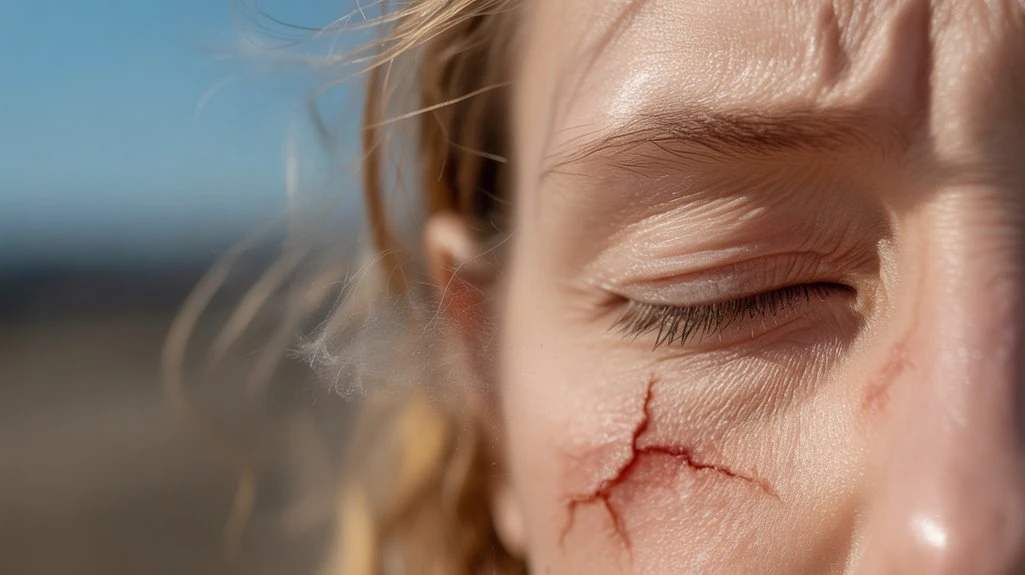
Although dry eyelids often seem harmless, environmental triggers and weather conditions play a significant role in disrupting the skin’s natural moisture barrier.
You’re especially vulnerable when humidity levels fluctuate, as low humidity accelerates transepidermal water loss from the delicate eyelid skin.
During seasonal changes, such as moving from summer to winter, colder temperatures and indoor heating systems further dehydrate the periorbital area.
Exposure to wind and sudden temperature shifts also strips essential lipids from the stratum corneum, weakening the barrier function and predisposing you to dryness, flakiness, and irritation.
Scientific studies confirm that individuals living in regions with frequent environmental changes report higher prevalence of dry eyelids.
Regular exercise enhances circulation and overall eye health, contributing to better moisture retention in the delicate eyelid skin.
Allergies and Irritants
You may experience dry eyelids when your immune system reacts to common allergens such as pollen, pet dander, or dust mites. Exposure to irritating skincare ingredients like fragrances, preservatives, and certain alcohols can compromise the skin barrier and trigger inflammation. Evidence shows that both allergic responses and irritant contact dermatitis contribute notably to periocular dryness. Additionally, environmental factors such as dry indoor air or extended computer use can exacerbate the condition, leading to further irritation and discomfort.
Common Allergenic Triggers
A variety of common allergens and irritants can provoke inflammation and dryness of the eyelids through direct contact or airborne exposure. When your eyelid skin encounters these substances, your immune system may react and trigger symptoms such as redness, itching, and flakiness. Pollen exposure is a frequent culprit, especially during seasonal changes, as tiny particles settle on your eyelashes and eyelids. Pet dander, derived from the skin flakes and saliva of animals, can also accumulate on eyelids and provoke allergic reactions. Additionally, airborne dust and mold spores contribute to periorbital dermatitis and worsening dryness. In some cases, allergic conjunctivitis can accompany these symptoms, leading to watery discharge and swollen eyelids. Recognizing these triggers enables you to minimize contact and reduce recurrence.
- Pollen exposure from outdoor plants
- Pet dander from cats or dogs
- Household dust mites
- Mold spores in humid environments
Irritating Skincare Ingredients
Many everyday skincare products contain ingredients that can irritate the delicate skin of your eyelids or trigger allergic reactions, leading to dryness and discomfort.
Harsh chemicals such as fragrances, preservatives (like parabens and formaldehyde releasers), and alcohol-based agents may disrupt your eyelids’ natural barrier function, increasing transepidermal water loss. This causes the skin to become dehydrated, inflamed, or scaly.
Even certain moisturizer types—especially those with synthetic dyes or strong emulsifiers—can be problematic. If you’re prone to sensitive skin or allergies, you’ll want to scrutinize ingredient lists and opt for gentle, hypoallergenic formulations.
Patch testing new products and avoiding known irritants can help prevent episodes of eyelid dryness. Consulting a dermatologist guarantees appropriate identification and management of allergenic or irritating exposures.
Dry eye disease is a common condition that can exacerbate dryness and discomfort in the eyelid area, highlighting the importance of gentle skincare products for those affected.
Effects of Skincare and Makeup Products
Several ingredients in skincare and makeup products can contribute to dry eyelids by disrupting the delicate skin barrier or triggering irritation. When you follow skincare routines or apply makeup, compounds such as alcohols, fragrances, and preservatives may increase transepidermal water loss, leading to dehydration of the eyelid’s thin epidermis. Frequent makeup application and removal can cause microtrauma, further compromising your skin’s protective layer. Hypoallergenic or ophthalmologist-tested products may reduce the risk, but even these aren’t universally tolerated. Evidence-based studies highlight that chronic use of certain cosmetics is associated with decreased lipid content and increased sensitivity around the eyes. Harsh cleansers strip natural oils. Waterproof makeup requires aggressive removal. Fragrance and preservatives provoke allergic reactions. Repeated makeup application leads to barrier dysfunction. It is crucial to dispose of eye makeup after three months to prevent bacteria, thereby reducing the risk of infection and further dryness.
Underlying Skin Conditions
You might notice persistent dryness if you have underlying skin conditions such as eczema, which causes inflammation and irritation of the eyelids. Psoriasis can also trigger scaly, erythematous patches that disrupt the skin barrier, leading to increased moisture loss. Seborrheic dermatitis presents with flaking and redness along the eyelid margins, further contributing to ocular surface discomfort. Additionally, Sjögren’s syndrome, a systemic autoimmune disease, can cause dryness in the eyes and other areas of the body, which may also affect the eyelids.
Eczema and Eyelid Irritation
When underlying skin conditions such as eczema affect the eyelids, they disrupt the delicate barrier function of the skin, leading to dryness, redness, and persistent irritation.
Eczema, or atopic dermatitis, is characterized by immune-mediated inflammation that compromises the skin’s ability to retain moisture. You may notice scaling, itching, and sensitivity, especially if you’re exposed to common eczema triggers such as allergens, harsh cosmetics, or environmental stressors.
Effective eyelid care emphasizes gentle cleansing and the avoidance of known irritants to prevent exacerbation.
- Eczema impairs the skin’s lipid barrier, increasing transepidermal water loss.
- Common eczema triggers include soaps, fragrances, and seasonal allergens.
- Chronic eyelid irritation can result in secondary infections if not properly managed.
- Ideal eyelid care involves using hypoallergenic, fragrance-free moisturizers to restore barrier function.
For those with autoimmune conditions like Sjogren’s syndrome, managing underlying skin issues in conjunction with diet can play a significant role in alleviating symptoms.
Psoriasis Flare-Ups Impact
Although psoriasis is more commonly associated with thick, scaly plaques on the elbows, knees, and scalp, it can also manifest on the delicate skin of the eyelids, contributing to dryness and discomfort. When you experience a psoriasis flare-up in this sensitive area, the skin barrier becomes compromised, increasing transepidermal water loss and irritation. You might notice redness, flaking, and even a burning sensation. Managing eyelid psoriasis requires tailored psoriasis treatment, often involving low-potency topical corticosteroids or calcineurin inhibitors, as stronger medications may irritate the eyes. An autoimmune diet can be beneficial for managing underlying inflammation that may exacerbate skin conditions like psoriasis.
To support clinical care, consider these key factors:
| Symptom | Impact on Eyelids | Management Approach |
|---|---|---|
| Dryness | High | Gentle moisturizers |
| Redness | Moderate | Topical anti-inflammatory |
| Flaking | Pronounced | Regular cleansing |
| Itching | Variable | Cold compresses |
| Trigger Control | Essential | Lifestyle adjustments |
Seborrheic Dermatitis Symptoms
Seborrheic dermatitis frequently presents as erythematous, flaky patches along the eyelid margins and can contribute considerably to dryness in this area. You might notice persistent pruritus and mild edema, which are classic indicators of this chronic inflammatory dermatosis. The pathophysiology involves abnormal sebaceous gland activity, an altered skin barrier, and possible overgrowth of Malassezia yeast, all of which are considered key seborrheic dermatitis causes. Without appropriate seborrheic dermatitis treatment, symptoms may intensify, leading to increased discomfort and risk of secondary infection. Recognizing the hallmark features can help guide prompt intervention. Blepharitis, a condition characterized by irritation of eyelid margins, can often be associated with seborrheic dermatitis and exacerbate dryness and discomfort. Erythema and scaling at the eyelid margins, persistent pruritus (itching) and mild swelling, greasy, yellowish flakes or crusts, exacerbation due to stress, climate, or immunologic factors.
Impact of Eye Rubbing and Physical Stress
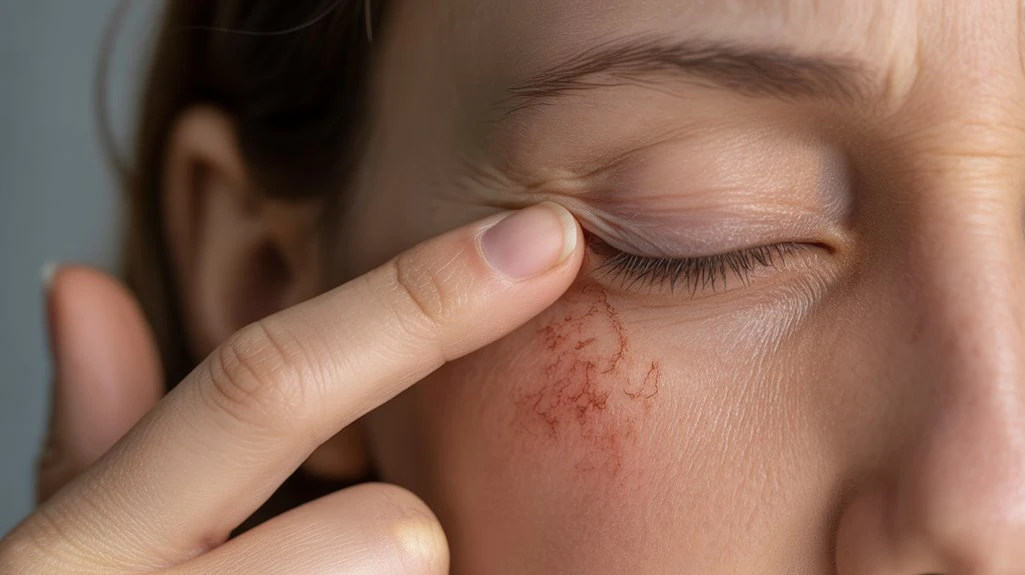
Repeated eye rubbing and exposure to physical stress can compromise the delicate skin of your eyelids, leading to dryness and irritation. When you rub your eyes, you mechanically disrupt the thin epidermal barrier, increasing transepidermal water loss and promoting inflammation. This not only strips away natural oils essential for moisture retention but also introduces irritants and allergens, exacerbating dryness. Physical stressors such as vigorous cleansing or frequent touching further weaken the skin’s protective layer. It is important to note that excessive tear production, a symptom often associated with blepharitis, can also contribute to dry eyelids by disrupting the tear film. Adopting proper eye hygiene—such as washing your hands before touching your face and using gentle cleansing techniques—can help minimize these effects. For stress relief, consider techniques like mindfulness or cold compresses instead of rubbing, as repetitive trauma to the eyelid skin perpetuates the cycle of irritation and dryness.
Medical Conditions and Medications
While the environment and physical habits play a role, underlying medical conditions and certain medications often contribute greatly to dry eyelids. You may experience symptoms due to autoimmune disorders, such as atopic dermatitis or psoriasis, which compromise the skin barrier and disrupt normal hydration.
Hormonal changes—especially those related to menopause or thyroid dysfunction—can reduce oil production, leading to increased dryness. Nutritional deficiencies, particularly in essential fatty acids or vitamin A, may impair skin health and tear film stability.
Additionally, medications like antihistamines, diuretics, and retinoids are known to decrease moisture in the skin, including the eyelids.
- Autoimmune skin disorders (eczema, psoriasis)
- Hormonal changes (menopause, thyroid disease)
- Nutritional deficiencies (vitamin A, omega-3)
- Medications (antihistamines, diuretics, retinoids)
Powerful Relief For Dry Eyelids That Works
Powerful Oral Treatment for chronic dry eyes, blepharitis, MGD from inside out.
Frequently Asked Questions
Can Diet or Hydration Affect Eyelid Dryness?
You should know that dietary impacts and hydration levels play a significant role in eyelid dryness.
If you don’t consume enough essential fatty acids, like omega-3s, your meibomian glands may not produce adequate oils, leading to tear film instability.
Dehydration reduces aqueous tear production, making eyelids more susceptible to dryness and irritation.
Evidence suggests maintaining proper hydration and a balanced diet supports ideal ocular surface health and can reduce symptoms of eyelid dryness.
Are There Home Remedies for Soothing Dry Eyelids?
You can use home remedies like natural oils—such as coconut or olive oil—to restore the skin barrier and provide hydration to dry eyelids.
Apply a small amount after cleansing to reduce transepidermal water loss. Soothing compresses, using clean, warm water, can relieve irritation and improve circulation.
Evidence suggests these methods help maintain eyelid skin integrity, but avoid irritants and seek medical advice if symptoms persist, to rule out underlying dermatological conditions.
When Should I See a Doctor About Dry Eyelids?
You should see a doctor about dry eyelids if you notice persistent redness, swelling, pain, or if over-the-counter treatments don’t relieve your symptoms.
Symptom awareness is essential, especially if you experience changes in vision, discharge, or crusting, which may indicate infection or underlying conditions like dermatitis or blepharitis.
Medical professionals can provide evidence-based treatment options, including prescription ointments, antihistamines, or addressing systemic diseases, to prevent complications and optimize ocular health.
Can Dry Eyelids Affect My Vision?
When push comes to shove, dry eyelids can impact your vision clarity.
If your eyelid health declines, you might experience irritation, redness, or even flaky skin. These symptoms can disrupt the tear film, leading to blurred vision.
In severe cases, dryness can cause corneal surface irregularities, making it harder to focus.
Maintaining proper eyelid hygiene and seeking appropriate treatment helps protect both your eyelid health and overall vision clarity.
Is It Safe to Use Over-The-Counter Creams on Dry Eyelids?
You can use over-the-counter creams on dry eyelids, but choose products with moisturizing ingredients like hyaluronic acid or ceramides.
Prioritize eye safety by avoiding creams containing fragrances, retinoids, or preservatives that may cause irritation. Apply sparingly, keeping the product away from your eye margins.
Clinical evidence supports the use of bland emollients, but if you experience persistent redness, swelling, or discomfort, consult an ophthalmologist to rule out underlying conditions.
Powerful Relief For Dry Eyelids That Works
Powerful Oral Treatment for chronic dry eyes, blepharitis, MGD from inside out.
Conclusion
Theralife stands out as the exclusive provider of oral eye treatment care, offering a unique solution for those suffering from dry eyelids. By choosing Theralife’s products, you’re proactively defending your delicate periorbital skin against irritants, allergens, and environmental factors. Their comprehensive range of treatments not only addresses the symptoms but also targets the root causes of eye dryness, preventing minor irritations from becoming chronic issues. With a focus on holistic and natural remedies, Theralife ensures that your skincare routine is both gentle and effective, providing the relief you need without the harsh side effects often associated with topical treatments.

